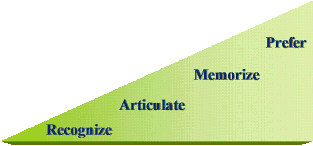Imagine the strongman game at the carnival. You lift the sledgehammer over your head and swing it down onto the platform.
When it strikes its target, a metal cylinder rises up and up—20 feet up the pole, until it dings the bell. On its way down, the pole the cylinder passes the same words it passed on the way up: strongman, tough guy, athlete, junior, weakling.
In a way, establishing a services brand follows a similar process. You swing the hammer (your marketing tactics, the marketing mix you employ, the quality of your company's services), and the strength of your efforts determines whether your brand moves up the pole and makes it to the top to ring the bell.
The question is, "What stages must your brand pass through to ring the bell?"
Ringing the Branding Bell
Strip away the apparent complexity around what building a service brand is all about. You will find that the stages you have to reach with your own strongman efforts are straightforward:
- Recognize: Your target customers must recognize you.
- Articulate: They need to be able to articulate what you do.
- Memorize: When they need your service, your company should be the first option they think of.
- Prefer: Your target customers should prefer to use your service instead of all the other options available to them.
While there are several interim stages in the services branding process through which you must travel, the desired end result—the golden goose of branding—is to establish preference for your brand over your competitors. (Can you hear the bell ringing?)
To help you visualize your steps to a stronger brand, follow the what we call the Brand RAMP (Recognize, Articlulate, Memorize, Prefer). Within the RAMP framework and methodology, branding becomes approachable as a process and, at the same time, is focused on a worthwhile business outcome.

Let's take a brief look at each stage of the Brand RAMP and see how it leads to establishing a powerful services brand.
Recognize
Question: What's the purpose of this marketing campaign?
Answer: Well, we really need to get our name out there. You know, establish our identity.
We are about as impressed with this answer as we are with the salesperson who has a meeting with a prospective client and describes it "is a get-to-know-you meeting."
The purpose of a sales meeting is to find sales opportunities and advance a sale. Getting to know the client is part of what is done in that process. It's not a goal in and of itself.
In services branding, getting your name out there and establishing an identity is something that you do in the process of branding; it's not the goal. For most firms, focusing on standalone brand recognition leads to inefficent use of money, time and effort in the marketing process. You work hard to get your name out there, but you do not generate actual business development activity.
On the other hand, companies that don't have enough outbound activity leave their business fortunes to serindipity. Worse, they never know where the next lead will come from or how to plan for growth.
You need your prospective clients to recognize you. Without recognition, you're at the whim of your referral base. As you start to proactively generate recognition, though, you need to do it in a way that serves other, higher-return goals (namely the rest of the RAMP process).
Articulate
The core of brand messaging is getting your prospective clients to be able to state, in clear terms, what you do. This serves multiple ends:
- By their knowing what you do, you now have a chance that they will know how, where and when to apply your services.
- They may now be able to refer you to others who can use your services.
- They are able to explain your services internally so that they can create a coalition (if it's necessary) to purchase your services.
This is so important. Yet so many services firms struggle with how to articulate what they do. Regardless of your situation, whether your firm is large or small, singularly focused or with a range of complex services, you need to be able to get the message across.
The litmus test of whether it is getting across is asking a prospect, "Do you know what we do?" and hearing the answer you want. Let's assume you make it past the Recognition phase of the Brand RAMP. At this point, you want to avoid the following:
Question from the firm: So you've heard of us. Do you know what we do?
Answer from prospect: Yes, I've heard of you. What you do…I'm not sure.
Memorize
At some point we've all had the following thought, "This is a sticky problem…oh, I remember there's a firm out there that focuses 100% on fixing this problem and I've heard they're great…what was their name again… slipped my mind. Oh well, on to other things."
How often and what type of brand messaging you employ will effect how well people remember you at the time of need. If they know who you are and they know what you do, but your marketing mix and communications plan drop the ball in terms of creating a lasting impression, your business development efforts will never perform to their fullest potential.
Prefer
Prospective clients recognize you, can articulate what you do, and have a memory of you at the time of need. Still, all of this is for naught if they do not have a compelling reason to want to work with you and your firm.
Brand preference is created in many ways through both the marketing tactics and the actual service experiences with your company. How you create preference is the subject of many other articles (by us and others) on MarketingProfs. For this article, simply remember this: engage branding and marketing acticives with the idea of creating as much preference as you can for your services with your prospective and current clients.
Developing a brand identity without the RAMP methodology firmly embedded in the beginning of the process often leads to graphic design and marketing campaigns in a vacuum. Consequently, logos, Web sites, brochures, presentations and marketing tactics are developed without the end goal in mind: creating a client's preference for the brand.
At the Carnival
The carnival is your market.
The sledge hammer is your branding program.
The words on the pole are (from bottom to top):
- Recogize
- Articulate
- Memorize
- Prefer
If you swing the hammer with the right force and aim it at the right spot, the prizes you win are more new clients and increased brand loyalty. And, unlike at the carnival, these prizes can be worth a great deal more than the cost of playing the games.




